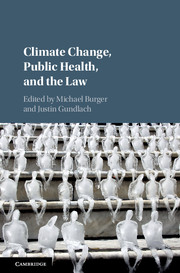Book contents
- Climate Change, Public Health, and the Law
- Climate Change, Public Health, and the Law
- Copyright page
- Contents
- About the Contributors
- Foreword
- Part I The Context
- 1 Introduction
- 2 The Duty to Protect Public Health from Climate Change Impacts
- 3 The Public Health Sector’s Challenges and Responses
- Part II Cross-Cutting Issues
- Part III Impacts and Interventions
- Part IV Interplay with International & Domestic Environmental Law
- Index
3 - The Public Health Sector’s Challenges and Responses
from Part I - The Context
Published online by Cambridge University Press: 05 October 2018
- Climate Change, Public Health, and the Law
- Climate Change, Public Health, and the Law
- Copyright page
- Contents
- About the Contributors
- Foreword
- Part I The Context
- 1 Introduction
- 2 The Duty to Protect Public Health from Climate Change Impacts
- 3 The Public Health Sector’s Challenges and Responses
- Part II Cross-Cutting Issues
- Part III Impacts and Interventions
- Part IV Interplay with International & Domestic Environmental Law
- Index
Summary
Climate change poses an extraordinary and unprecedented threat to human health, not only by producing direct health consequences, but also by exacerbating disparities in social determinants of health and by adversely affecting ecosystems, food systems, and public health infrastructure. To date, United States public health responses to climate-related health effects have been shaped largely by the Centers for Disease Control & Prevention’s Building Resilience against Climate Effects (BRACE) framework. Public health activities have primarily focused on assessing potential health impacts and developing responsive interventions. The Five Essential Public Health Law Services framework, which provides a series of iterative steps based upon past successes in public health, may help to build the field’s capacity to communicate, implement, and evaluate legal interventions. When crafted through cross-sectoral collaboration and grounded in principles of health equity, the law may serve as an effective tool for building climate resilience and ameliorating the adverse health effects of climate change.
- Type
- Chapter
- Information
- Climate Change, Public Health, and the Law , pp. 34 - 72Publisher: Cambridge University PressPrint publication year: 2018
- 1
- Cited by

